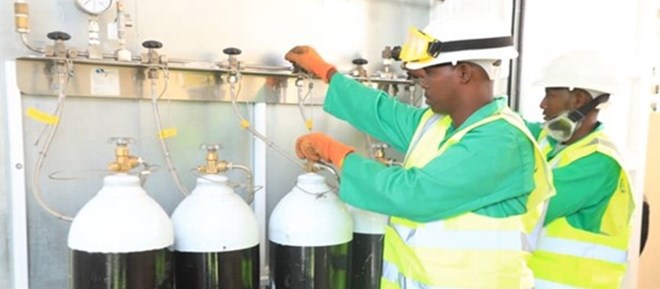
Tuesday June 7, 2022
By BERNARD OLAYOCARMEN CARPIO

Technicians learn how to fill oxygen cylinders from a pressure swing absorption (PSA) oxygen plant at De Martino hospital in Mogadishu, March 2022. Photo: Bile Abdi/Ministry of Health, Somalia Crisis Recovery Project Team
As the COVID-19 (coronavirus) pandemic spread across Africa, hospitals across the continent faced shortages of essential medical supplies needed to treat the respiratory disease and keep patients alive. Not just masks and ventilators, but oxygen.
For people living in wealthy countries, medical oxygen is often taken for granted. In many low-income countries such as Somalia however, oxygen is often in short supply or not available at all. And globally, a lack of oxygen—needed to treat pneumonia, malaria, and other diseases—leads to hundreds of thousands of deaths each year.
Today, Somalia has reported 26,439 cases and 1,361 total deaths, with a case fatality ratio of 5.14%. The challenges of COVID-19 have taken a toll on Somalia as the country has the seventh highest case fatality ratio globally.
Different to many countries, Somalia was dealing with multiple threat of crises: locusts, drought, flooding + COVID-19. Add to this the country’s fragility, after decades of war and political instability. This context of conflict and fragility limited the country’s ability to deliver much needed health services and supplies across the country due to inaccessibility for security reasons. Decades of war have also meant that no significant investments have been made in improving health infrastructure and as a result, Somalia health infrastructure is very poor or non-existent in many places.
So what was Somalia to do as it faced a growing threat of COVID-19 with increased severity?
The country responded. In September 2020, the country activated the Contingent Emergency Response Component (CERC) under the World Bank-financed Somalia Crisis Recovery Project (SCRP). Approved on May 15, 2020, the SCRP was visionary by including a CERC component in its original design. This allowed Somalia flexible and agile financing channels to allow them to respond to the COVID-19 emergency. Once COVID-19 was declared a public health emergency of international concern, the Government of Somalia, activated the CERC, which guided investments and activities.
Still, the issue of ensuring access to services and supplies remained a question due to security reasons.
Enter International Organization for Migration (IOM), the World Health Organization (WHO), and the United Nations’ Children’s Fund (UNICEF). The Somalia government and World Bank looked to partners with in-country presence who could support direct and timely procurement of COVID-19 materials and equipment—which were being rapidly snatched up globally—and who could provide an implementation support arm to the government.
With the strong engagement of partners such as the World Health Organization (WHO), UNICEF and the International Organization for Migration (IOM) supporting implementation and available funding through the CERC for immediate response needs, the country embarked on a much-needed effort to ensure access to much-needed medical oxygen to treat the more severe cases of COVID-19.
Through the activated CERC, the IOM procured and installed a pressure swing adsorption (PSA) oxygen plant for the Galmudug State which was installed at the Galgadud General Hospital and has been operational since March 9, 2022. PSA oxygen-generating plants are a source of medical-grade oxygen. The Federal Ministry of Health (FMOH) of Somalia built on this first effort and procured further PSA oxygen plants through the CERC for Jubaland to be installed at Kismayo General Hospital, for South West State to be installed at Baidoa General Hospital, and for Hirshabelle State to be installed at the Baladweyne General Hospital to be delivered this month.
To complement World Bank CERC funding, the Government of Somalia utilized European Union financing, with WHO procurement and implementation, for PSA oxygen plants at the De Martino Hospital, Garowe General Hospital in Puntland State, both of which are operational, for Hargeisa in Somaliland which is planned for delivery in the second half of 2022, and co-financing the Baladweyne General Hospital oxygen plant with the World Bank. The FMOH has also engaged the private sector with oxygen plants installed at the De Martino Hospital by Dahabshiil and at Banadir Hospital by the Hormuud Salama Foundation.
Today, Somalia has several PSA oxygen plants in operation with plans for more. Somalia was able to tap into emergency financing through the CERC to support the purchase of supplies and equipment for the immediate response to the pandemic, and use the CERC to help strengthen the capacity of its health system to treat the more severe COVID-19 patients. While this capacity was created with a mind-set to address the immediate COVID-19 need, it ended up developing a sustainable medical oxygen supply system in the country, thereby strengthening the overall hospital response capacity at the central and state levels. As H.E. Dr. Fawziya Abikar said during the handing over of an oxygen plant at the country’s main Covid-19 hospital (De Martino hospital) earlier this year, “This support [supply of oxygen PSA oxygen plants across states in Somalia by various donors] is part of a strategic roadmap to boost oxygen supply in hospitals across the country”.
Oxygen is normally considered to be something you cannot see, cannot smell, and cannot touch. However, in the case of Somalia, thanks to the coordinated strategy of the Government of Somalia with its partners, oxygen is something you can definitely see across the regional hospitals in Somalia. These investments will not only help with addressing COVID-19 pandemic, but other perennial diseases including pneumonia that will persist long after the pandemic. To reap maximum benefits from these plants, the government and partners need to develop a robust plan for repair and maintenance, which includes stockpiling of spare parts and service kits. Congratulations to the Government of Somalia for this coordinated effort which is now pumping oxygen across the Somalia health system!